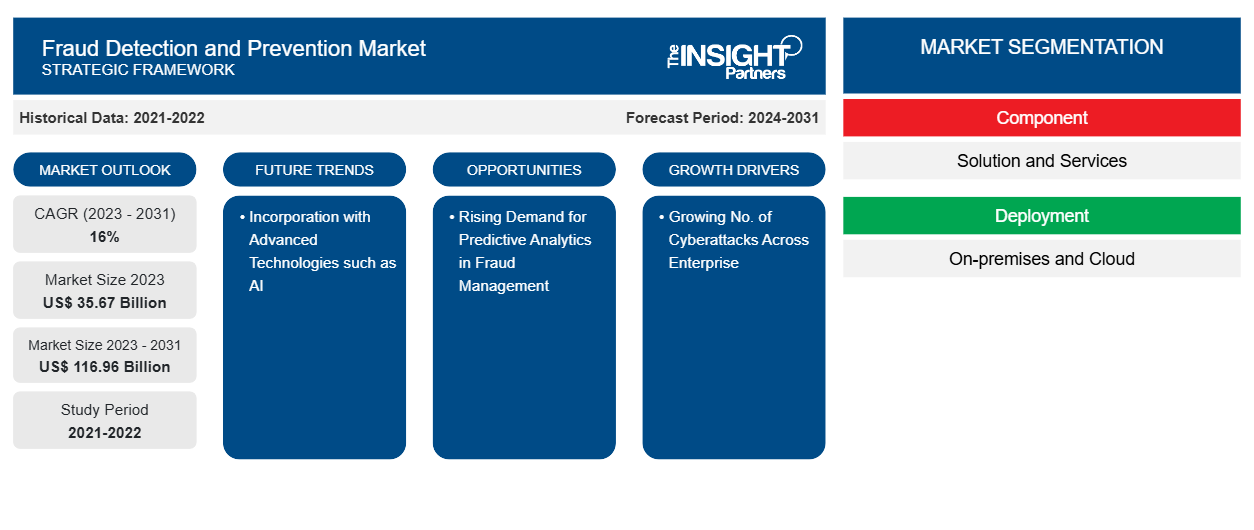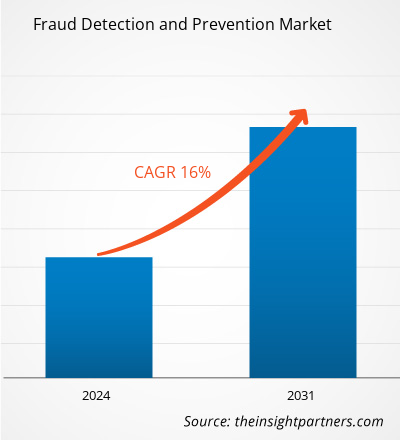The fraud detection and prevention market size is projected to reach US$ 116.96 billion by 2031 from US$ 35.67 billion in 2023. The market is expected to register a CAGR of 16.0% during 2023–2031. The incorporation of advanced technologies such as AI is likely to remain a key trend in the market.
Fraud Detection and Prevention Market Analysis
The increasing prevalence of online fraud and advanced cyberattacks globally is driving the need for fraud detection and prevention solutions. Moreover, the increasing trend toward utilizing advanced analytics for identifying threat patterns is contributing to the expansion of the fraud detection and prevention market. Furthermore, due to the rising trend of digitization and the popularity of e-commerce transactions, there is also a growing need for fraud detection and prevention solutions to combat the increasing online fraud threats that involve sensitive data, identity information, and personal information of individuals and businesses. Moreover, the anticipated growth of the fraud detection and prevention market in the future will be driven by the rising use of advanced technologies such as Al and ML to identify and prevent fraud.
Fraud Detection and Prevention Market Overview
Digital publishing, known as electronic or online publishing, involves disseminating various online content like journals, magazines, newspapers, and eBooks. By going through this process, any business or publishing entity can convert paper documents and data into digital format, which can be accessed online, downloaded, edited, and printed or shared at the discretion of users.
Customize This Report To Suit Your Requirement
You will get customization on any report - free of charge - including parts of this report, or country-level analysis, Excel Data pack, as well as avail great offers and discounts for start-ups & universities
Fraud Detection and Prevention Market: Strategic Insights

-
Get Top Key Market Trends of this report.This FREE sample will include data analysis, ranging from market trends to estimates and forecasts.
Fraud Detection and Prevention Market Drivers and Opportunities
Growing No. of Cyberattacks Across Enterprise to Favor Market
Cybersecurity risks are a significant issue in the current digital landscape. Serious repercussions affect individuals, corporations, and governments. It is crucial to prevent cyber-attacks. The increase in cyber-attacks has elevated the significance of cybersecurity for protecting crucial infrastructures and ensuring the security of people and businesses. Fraud detection and prevention solutions are now seen as essential tools for companies to protect themselves from online attacks. Using the software can assist companies in boosting sales with valuable clients, boosting approval rates, minimizing reserve account needs, avoiding chargebacks, and much more. Consequently, the rise in cyberattacks within businesses is leading to a higher need for fraud prevention options, driving the expansion of the fraud detection and prevention industry.
Rising Demand for Predictive Analytics in Fraud Management
Predictive analytics is an advanced strategy for preventing fraud that uses data, statistical algorithms, and machine learning methods to predict future events based on past data analysis. In essence, predictive analytics involves predicting unforeseen future occurrences, and within the realm of fraud prevention, it is essential for detecting and minimizing possible fraudulent behaviors proactively. Predictive models use historical data analytics and user behavior to identify patterns that suggest the presence of fraud. For instance, a model that is trained on data containing fraudulent occurrences will be able to identify and highlight comparable patterns in fresh cases, such as call records, frequencies, or abnormal user actions.
Fraud Detection and Prevention Market Report Segmentation Analysis
Key segments that contributed to the derivation of the fraud detection and prevention market analysis are content component, deployment and end user.
- Based on component, the market is segmented into solution and services. The solution segment held a significant market share in 2023.
- Based on deployment, the market is segmented into on-premises and cloud. The on-premises segment held a significant market share in 2023.
- In terms of end user, the market is bifurcated into BFSI, healthcare, manufacturing, retail, telecommunication, and others. The BFSI segment held a substantial share of the market in 2023.
Fraud Detection and Prevention Market Share Analysis by Geography
The geographic scope of the fraud detection and prevention market report is mainly divided into five regions: North America, Asia Pacific, Europe, Middle East & Africa, and South & Central America.
The US is expected to dominate the fraud detection and prevention market in North America in 2023. The retail and e-commerce sectors in North American countries such as the US and Canada are strong. Over 60% of Americans participate in online shopping for essential and luxury items they need in their everyday routines. Also, the United States ranks as the world's second-largest e-commerce market. The US Census Bureau reported that retail e-commerce sales in the first quarter of 2023 reached US$272.6 billion, marking a 3% growth from the previous quarter in 2022. Likewise, as stated by the International Trade Administration (ITA), around 27 million individuals in Canada were utilizing e-commerce in 2022, which equates to 75% of the Canadian populace, with projections showing an increase to 77.6% by 2025. E-commerce sales were at approximately US$ 2.34 billion in the country in March 2022, with projected growth to US$ 40.3 billion by 2025. The increasing acceptance of online shopping in the area is leading to a significant need for measures to prevent fraud, as it involves sharing sensitive information of individuals and companies. Therefore, the expansion of the e-commerce sector in the area is driving the market in North America.
Fraud Detection and Prevention Market Regional Insights
The regional trends and factors influencing the Fraud Detection and Prevention Market throughout the forecast period have been thoroughly explained by the analysts at The Insight Partners. This section also discusses Fraud Detection and Prevention Market segments and geography across North America, Europe, Asia Pacific, Middle East and Africa, and South and Central America.
Fraud Detection and Prevention Market Report Scope
| Report Attribute | Details |
|---|---|
| Market size in 2023 | US$ 35.67 Billion |
| Market Size by 2031 | US$ 116.96 Billion |
| Global CAGR (2023 - 2031) | 16% |
| Historical Data | 2021-2022 |
| Forecast period | 2024-2031 |
| Segments Covered |
By Component
|
| Regions and Countries Covered |
North America
|
| Market leaders and key company profiles |
|
Fraud Detection and Prevention Market Players Density: Understanding Its Impact on Business Dynamics
The Fraud Detection and Prevention Market is growing rapidly, driven by increasing end-user demand due to factors such as evolving consumer preferences, technological advancements, and greater awareness of the product's benefits. As demand rises, businesses are expanding their offerings, innovating to meet consumer needs, and capitalizing on emerging trends, which further fuels market growth.

- Get the Fraud Detection and Prevention Market top key players overview
Fraud Detection and Prevention Market News and Recent Developments
The fraud detection and prevention market is evaluated by gathering qualitative and quantitative data post primary and secondary research, which includes important corporate publications, association data, and databases. A few of the developments in the fraud detection and prevention market are listed below:
- NICE Actimize, a NICE business (Nasdaq: NICE), today announced the availability of IFM 11 (Integrated Fraud Management), a new release of its market-leading, AI-driven fraud management and detection platform. The new release leverages recent advancements in artificial intelligence together with NICE Actimize’s unique collective intelligence capabilities to introduce unprecedented fraud detection accuracy, agility and efficiency to protect financial services firms and their customers from the next generation of AI-driven fraud and scams.
(Source: NICE Actimize, Press Release, April 2024)
Fraud Detection and Prevention Market Report Coverage and Deliverables
The “Fraud Detection and Prevention Market Size and Forecast (2021–2031)” report provides a detailed analysis of the market covering below areas:
- Fraud detection and prevention market size and forecast at global, regional, and country levels for all the key market segments covered under the scope
- Fraud detection and prevention market trends as well as market dynamics such as drivers, restraints, and key opportunities
- Detailed PEST/Porter’s Five Forces and SWOT analysis
- Fraud detection and prevention market analysis covering key market trends, global and regional framework, major players, regulations, and recent market developments
- Industry landscape and competition analysis covering market concentration, heat map analysis, prominent players, and recent developments for the fraud detection and prevention market
- Detailed company profiles
Frequently Asked Questions
What would be the estimated value of the fraud detection and prevention market by 2031?
What is the expected CAGR of the fraud detection and prevention market?
Which are the leading players operating in the fraud detection and prevention market?
What are the future trends of the fraud detection and prevention market?
What are the driving factors impacting the fraud detection and prevention market?
- Historical Analysis (2 Years), Base Year, Forecast (7 Years) with CAGR
- PEST and SWOT Analysis
- Market Size Value / Volume - Global, Regional, Country
- Industry and Competitive Landscape
- Excel Dataset
Recent Reports
Testimonials
Reason to Buy
- Informed Decision-Making
- Understanding Market Dynamics
- Competitive Analysis
- Identifying Emerging Markets
- Customer Insights
- Market Forecasts
- Risk Mitigation
- Boosting Operational Efficiency
- Strategic Planning
- Investment Justification
- Tracking Industry Innovations
- Aligning with Regulatory Trends





















 Get Free Sample For
Get Free Sample For